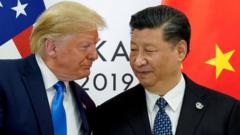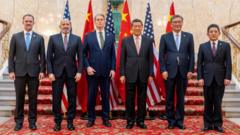As Malaysia endeavors to transition from semiconductor assembly to high-end technology design, the challenges presented by President Trump's tariffs threaten its ambitions.
A Semiconductor Ambition: Malaysia's Strive Amid U.S. Tariffs

A Semiconductor Ambition: Malaysia's Strive Amid U.S. Tariffs
Malaysia aims to elevate its semiconductor industry amidst uncertainties posed by U.S. trade policies.
The narrative surrounding Malaysia's role in the semiconductor industry is deeply intertwined with global trade dynamics. The country's Penang State has long attracted American tech giants, with companies like Intel, AMD, and HP establishing manufacturing bases over the past fifty years. This has fostered an environment that not only creates thousands of jobs but also positions Malaysia as a pivotal exporter of semiconductors, supplying essential components for various technological applications.
Recently, however, Malaysia finds itself navigating the tumultuous waters of American trade policy, particularly the tariffs implemented during Trump's administration. Initially viewed as a strategic beneficiary of the U.S.-China trade tensions, Malaysia's aspirations began to peak with Prime Minister Anwar Ibrahim's vision to revolutionize the country's semiconductor landscape. His government set forth a ten-year, multibillion-dollar initiative aimed at transitioning the nation from mere assembly to advanced semiconductor design and production, similar to industry leaders in Taiwan.
Nonetheless, the recent implementation of a 24% tariff on Malaysian exports to the United States has raised significant concerns. While the levy faced a temporary suspension amid ongoing negotiations, the uncertainty surrounding these discussions and the baseline 10% tariff imposed by Trump complicates Malaysia's high-tech ambitions. Furthermore, the potential consideration for a blanket levy of at least 25% on all semiconductor imports adds another layer of unpredictability for Malaysian manufacturers.
Industry experts like Julia Goh, a senior economist at UOB in Singapore, note that the ramifications of such policies could steer more semiconductor production back to the U.S., jeopardizing Malaysia's vital role in the global supply chain. As the clock ticks on its strategic plans, Malaysia's semiconductor aspiration hangs in the balance, caught between a desire for innovation and the harsh realities of trade policy changes.





















